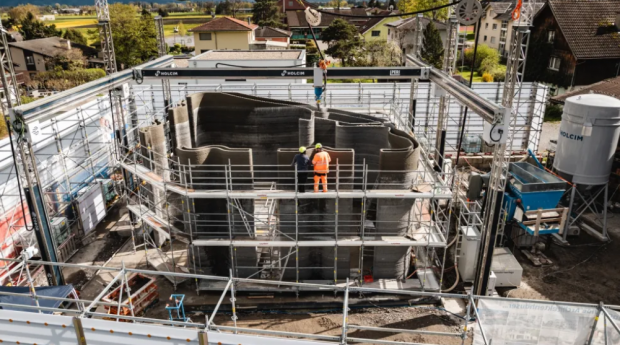Holcim Switzerland and construction company Kobelt AG are pioneering 3D printing technology to construct a showroom, showcasing its potential in the building industry. Learn more about this innovative approach, which reportedly reduces material usage and minimizes the carbon footprint of construction projects.

(Photo : Holcim/Holcim)
Construction of the First Onsite 3D Printed Building in Switzerland
According to Kevin Bohlen, Project Manager at Holcim Switzerland, the board of directors of a construction company named Kobelt AG decided to construct a new space for the showroom on the grounds of the existing office rather than expanding the office using 3D printing. In Switzerland, three-dimensional concrete printing is still considered a relative novelty; nonetheless, Holcim is demonstrating what is feasible and establishing new benchmarks with our cutting-edge technologies. The construction company Kobelt AG is experiencing tremendous expansion and has just begun constructing this display pavilion.
As mentioned, by enabling innovative design, 3D printing can minimize the amount of material used by up to 50%, allowing for better construction with fewer materials while maintaining the same level of performance. This technological advancement can also lower a building or structure's carbon footprint and contribute to developing circular buildings to preserve our world's resources.
On the other hand, using 3D concrete printing technology, a distinct variety of concrete is procedurally deposited in successive layers, eliminating the necessity for formwork. According to a digital 3D model generated in the past, this is carried out to make the procedure more efficient in terms of both time and resources. To offer a novel alternative to the mortar often utilized in 3D printing, the company used a COBOD printer to manufacture a unique concrete for the showroom.
This particular variety of concrete is distinguished by its greater strength and the fact that it includes less cement than mortar, which results in a favorable environmental impact. Other advantages include the primary components of concrete, namely sand and gravel, being readily available in the surrounding area.
Also Read: 6 Dynamic Installation Techniques for Pile Foundation
Other Advantages of Using 3D Printing In Construction
The idea behind three-dimensional printing is straightforward to grasp. The formation of an image is accomplished by using a print head equipped with inkjets to apply ink to a sheet of paper. The fundamental structure of 3D printing is comparable to that of traditional printing. A three-dimensional print is created using a rigid and impermeable surface rather than paper and a semi-solid material comparable to toothpaste in place of ink. Measuring the print's width, length, and height is now possible.
Accordingly, 3D printing technology can benefit the building sector in several ways. In addition to providing increased design flexibility and enhanced functionality, it enables the customization of parts and components to a particular project. It is also possible to considerably cut down on waste by utilizing only the material required to construct a structure, which results in cost savings and improves the project's sustainability.
Furthermore, because components and materials can be manufactured rapidly onsite, 3D printing can accelerate the construction process and, ultimately, the completion of projects. The number of hazardous jobs employees must perform can also be decreased, which is another way to increase safety.
Although there may be a considerable initial investment needed for 3D printing technology, the efficiency of this technology and its other advantages result in cost savings over the lifetime of the equipment. In general, the prospective benefits of 3D printing establish it as a promising technology within the construction sector.
Related Article: 7 Essential Features Every Structure Should Have to Be Considered Sustainable Buildings







